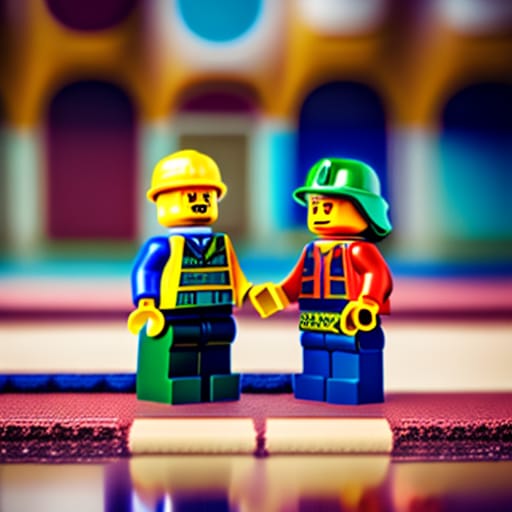From the iconic plastic bricks to a worldwide community of devoted fans, LEGO spans generations and brings joy to millions. Yet behind the simple pleasure of clicking those colorful pieces together, there exists a rich terminology and subculture waiting to be unlocked.
This beginner’s guide will decode the key terms every LEGO novice should know. You’ll learn the basic anatomy of a LEGO brick, explore the different themes and series that make up the LEGO universe, meet AFOLs (Adult Fans of LEGO), understand the nuances between elements, sets, and minifigures, and more LEGO lingo that will turn casual builders into master creators.

The Importance of Learning LEGO Jargon
As with any hobby, LEGO comes loaded with its own unique vocabulary. While the creative freedom of those tiny plastic bricks seems universal, you’ll gain much more from the experience by learning terms like “clutch power”, “CCBS” (Character and Creature Building System), “greebling”, and others that unlock deeper understanding.
Knowing the names of key LEGO parts lets you follow instructions better, especially for complex builds. When fellow LEGO fans start discussing MOCs, POOPs, and the NPU, you’ll be able to join the conversation instead of feeling left out. Learning the descriptors for colors, shapes, and styles opens you to nuances you never noticed before.
Perhaps most importantly, familiarity with LEGO terminology gives you a toolbox for translating the visions in your imagination into tangible block-based creations. Just as a musician must know notes and a painter needs pigments, a “master builder” works from a rich LEGO lexicon to fully express themselves.
A Brief History of LEGO Jargon
While plastic bricks have been at the core of LEGO for over 60 years, the vocabulary surrounding them has grown increasingly specialized. In the company’s early days, sets came with spare parts simply called “bricks” without elaborate classification. By the 1970s, LEGO started branding its products into themes like Town, Castle, and Space.
With licensed series based on movies and comics in the 1990s and 2000s, more complex build techniques emerged. This spurred the development of advanced building vocabularies. The rise of adult fans further expanded the lexicon, especially as AFOLs reclaimed childhood nostalgia and bonding experiences through LEGO conventions and online groups.
Today’s LEGO language contains a rich mixture of corporate branding terms, Fan culture lingo, and the specialized words needed to create intricately detailed MOCs. New products like CCBS and BIONICLE have been added to the dictionary, while the iconic 2×4 brick remains at the heart of this evolving system.
Anatomy of a Basic LEGO Brick
Before delving into more advanced terminology, start with the most classic component of any LEGO set—the standard LEGO brick. Though these have come in various sizes over the years, the basic brick measures 8 mm × 16 mm × 9.6 mm. Their distinct, repetitive shape allows for nearly endless interlocking combinations.
These parts also feature critical technical elements that enable LEGO’s trademark versatility:
Clutch Power – the ability of a brick to “grip” other pieces tightly in place through friction
Tube – the hollow underside into which studs click and grip
Stud – the round or cylindrical protrusion used to fasten bricks together
Baseplate – flat pieces with solid bottoms that anchor creations
Learning the Lingo: Key LEGO Terms and Concepts
Any hobby comes loaded with insider language, and the world of LEGO is no exception. Here are some of the fundamental terms LEGO fans use regularly that newcomers should learn.
AFOL
AFOL stands for Adult Fan Of LEGO. You might associate those colorful little bricks with children, but LEGO has an enormous following among grown-up fans as well, known as AFOLs.
AFOLs account for 5-10% of all LEGO sales and participate in the advanced building as an artistic medium. Browse LEGO subreddits and online forums to see their jaw-dropping custom creations.
ABS
The acrylonitrile butadiene styrene plastic compound used to mold LEGO bricks is shortened to ABS in LEGO lingo. ABS was chosen for its glossy, durable properties and ability to firmly “clutch” bricks placed upon it.
System
The elaborate series of bricks in coordinated shapes/sizes following LEGO’s building principles is known as the LEGO System. New additions introduced each year must adhere to the grid-based standards that enable freeform creativity.
CCBS
The Character and Creature Building System launched in 2011 offers an alternate style of Technic-based components for building LEGO action figures vs standard minifigs.
CCBS features ball and socket joints for roleplaying at a bigger scale.
Minifigure
The charming 4 cm tall LEGO people are officially known as “minifigures” or “minifigs.” These little yellow citizens of the LEGO world continue to evolve with more diversity and personalization.
| Minifigure | Mini Doll |
|---|---|
| 4 cm tall | Slightly taller |
| Cylindrical heads | Naturalistic sculpted heads |
| Limited articulation | More movable limbs |
| Focus on construction play | Roleplaying-centric |
Brick Separator
Every seasoned LEGO builder knows the frustration when favorite creations get jammed together. Thankfully, the handy brick separator helps pry pieces apart again without damage.
This orange plastic wonder avoids bitten fingernails when taken apart.
POOP
No, this is not bathroom humor! POOP is an acronym standing for Piece Out Of Place—a term used when the wrong brick ends up in a set during manufacturing.
MOC
MOC means “My Own Creation.” It refers to any original LEGO build someone designed outside of an official kit. MOCs allow the ultimate freedom of expression.
LEGO enthusiasts pour endless creativity into these unique projects based on movies, video games, objects, or pure imagination.

Advanced LEGO Lingo and Concepts
Once you’ve mastered the basics, dive deeper into advanced LEGO terminology that unlocks new insights into set designs, part classification, and the many LEGO subthemes.
Set Numbers
All LEGO products come marked with multi-digit serial numbers that reveal useful coded information about that kit. Here’s how to decipher them:
7958 – The first digits show which year the set was released. This code means 2009.
58 – The next pair reveals type/size details. 50s are Star Wars, 80s are City, etc.
001 – The last three digits identify this specific set.
So 7958-58-001 decodes to Star Wars, year 2009, set #1.
Design IDs
The Design ID numerically identifies the shape of a brick across brands so third parties can manufacture compatible options. For example, a classic 2×4 LEGO brick carries Design ID 3008.
| Brick Name | Design ID |
|---|---|
| 2×4 | 3008 |
| 1×2 Plate | 3020 |
| 2×2 Plate | 3022 |
| 2×2 Brick with Axle Hole | 3957 |
Element ID
Tracking individual brick designs gets unwieldy across over 10,000 types, so LEGO assigns each unique piece an official Element ID instead. This allows easier cataloging.
For instance, the ubiquitous 2×4 brick carries Element ID 300121. Even minor variations like colors would all list under this common ID. The software can then calculate parts lists and building guides more easily.
| Part Name | Element ID |
|---|---|
| 2×4 Brick | 300121 |
| Wheel 31.8mm D. x 20mm | 6118495 |
| Eye Stalk Ø3.2 Shaft 2 – 90 degrees | 6020101 |
Color IDs
Alongside Element IDs, LEGO colors also get cataloged under Color IDs. This helps track production numbers and manage inventory in their massive molding factories.
Common colors have simple codes like Black = 1, Blue = 23, and Red = 21, while more obscure shades earn higher numbers. Glow-in-the-dark elements even claim Color ID 28!
| Color | Color ID |
|---|---|
| Black | 1 |
| Blue | 23 |
| Red | 21 |
| Glow in Dark Opaque | 28 |
Key Terms for Advanced Building Techniques
Experienced builders use various specialized techniques that draw from unique vocabularies. Get familiar with these key terms to level up your skills.
SNOT
Studs Not On Top Brickwork
Placing bricks sideways for smooth tiles rather than the studded side up. Achieves aesthetic effects. <—>
Irreversible Builds
One cycle builds that cannot be taken apart without destroying the model. Best practices suggest avoiding these.
Illegal Connections
Links between elements that stress or warp the parts. Trying to clip a 1×1 plate to a Technic pin is one example.
Greebling
Adding random layered detail to surfaces to create complex industrial-looking textures. Named after a Star Trek alien race.
Clipping
Forcing two elements to friction-fit together in ways LEGO does not endorse or support long-term.

Inside the World’s Most Popular Toys
With over 500 billion bricks manufactured so far, LEGO remains one of the world’s most beloved and ubiquitous toys for good reason – these simple plastic building blocks unleash creativity across generations.
Yet behind the iconic bricks lies a rich culture, language, and community for devotees to deeply immerse in. As you have seen from this introductory guide, LEGO terminology spans everything from official chemical compound abbreviations to fan-generated slang and coding systems for internal product management.
Learning this lexicon allows both casual builders and devoted AFOLs to better appreciate the nuances of bricks, elements, mini-figures, and licensed themes that make LEGO unique. Fluency in naming colors, decoding set numbers, appreciating advanced techniques like SNOT and greebling, and even just knowing what a “POOP brick” is will level up your shared experience.
While millions enjoy LEGO just snapping random pieces together into freeform sculptures, taking time to unlock the vocabulary opens up even more creative possibilities. You gain a deeper admiration for the care and quality underlying 60+ years of LEGO System evolution. And you can better participate in the thriving global community of AFOLs.
So don’t be intimidated by lingo like CCBS, MOCs, illegal joins, and the NPU. Add these and many more terms covered here to your LEGO knowledge base. Before long, you too will be fluently speaking that colorful language understood by kids and adult fans across generations.
Now get building – and talk bricks with fellow fans!
Frequently Asked Questions
What exactly is an AFOL?
AFOL stands for Adult Fan Of LEGO. This term refers to the grown-up fans who build LEGO either for fun, artistic expression, or even as a professional career. AFOLs create stunning MOCs (My Own Creations) and participate in online builder communities.
How do I know if my bricks are compatible with the official LEGO System?
For bricks to properly clutch and build, they must conform to LEGO’s official scaling and design principles. Check that toy bricks follow formatting standards like the Design ID system or meet strict specifications for clutch power. Avoid “illegal connections” that stress elements.
Where can I learn more advanced build techniques?
Beyond following kit instructions, many AFOL builders use specialized techniques like SNOT (studs not on top), greebling, or clipping to achieve complex models. Consult LEGO builder forums, YouTube tutorials, and sites like Rebrickable for tips. LEGO also offers its own Master Builder Academy program.
What are some accessories I should invest in for big LEGO projects?
Experienced builders recommend getting a brick separator for disassembling stuck creations. Look into storage containers and organizational parts like sorting trays to manage all those tiny elements. LED lighting kits let you illuminate your builds. And beware of losing essential bricks to the feared POOP (pieces out of place) phenomenon!
How do I identify the names of all the unique LEGO parts I own?
Rather than tracking tens of thousands of brick designs individually, LEGO assigns each unique piece an Element ID number and catalogs them in databases. So that common 2×4 brick carries Element ID 300121 regardless of its color. This helps with inventory tracking and building instructions.